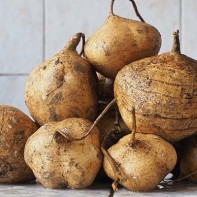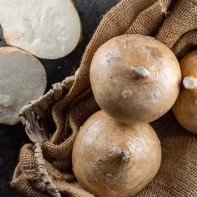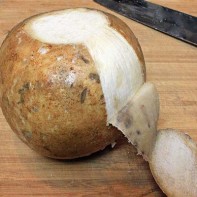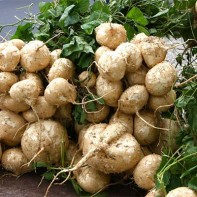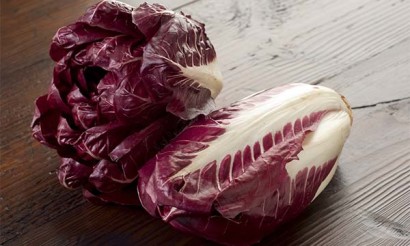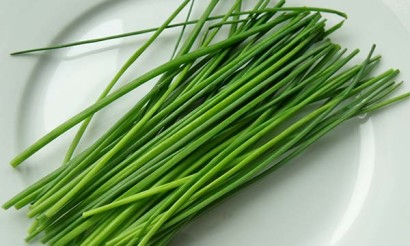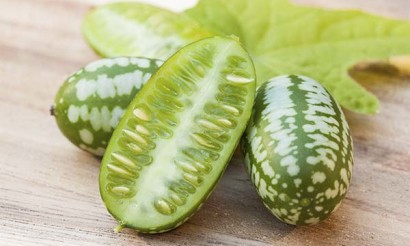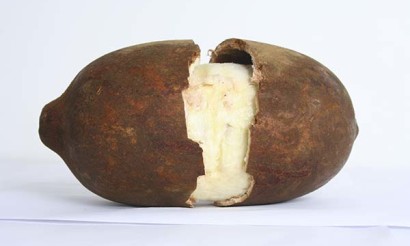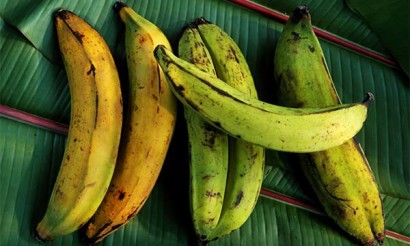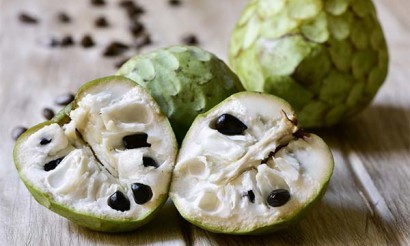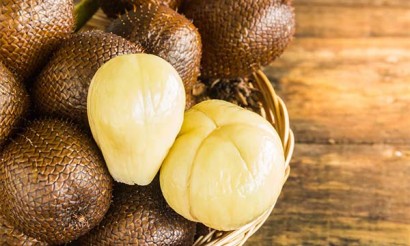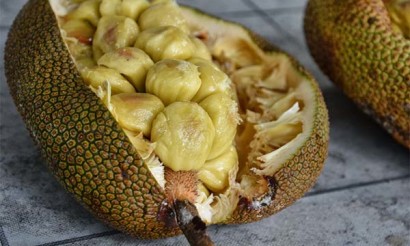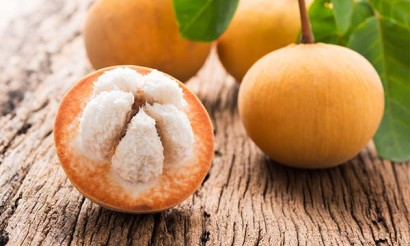Hikama: what is this vegetable and why is it useful?
Hickama is a rare guest on the shelves of European supermarkets. This herbaceous liana of the legume family is also called Jicama, Mexican yam, yam bean, pachyrizus. It is cultivated for its edible root vegetable, a dish commonly used in Mexico.
- What this vegetable is
- What it looks like
- Where it grows
- What's the use of chicama
- What harm it can do
- How to eat Hikama
- What you can make with hickama
- Salad of carrots, dates, raisins and pahirizus
- Layered sweet salad
- Quick hickam vegetable soup
- Guacamole sauce
- Dumplings with shrimp
- Traditional medicine
- Cosmetic Applications
- How to grow it
What is this vegetable
Mexicans have been growing this vegetable since ancient times, both for their own consumption and for feeding livestock. The vines rise several meters above the ground. In the natural environment, white or yellow flowers can adorn the plant for 9 to 10 months of the year. The pods, which can be up to 20 cm long, contain seeds. The entire ground part of the plant contains rotenone and is therefore inedible. It is used by locals to make remedies to repel and kill insects.
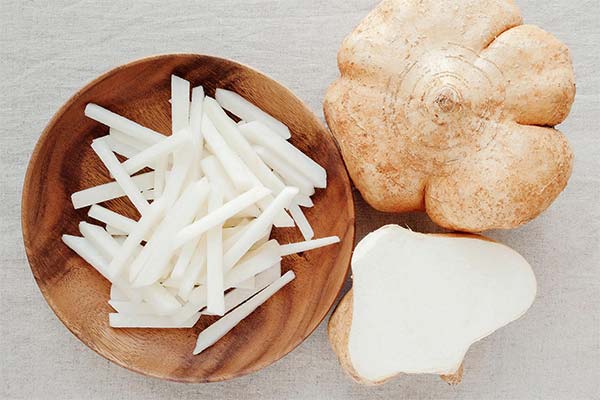
Only the round part of the root is eaten. The rest of the offshoot is no less poisonous than the herbaceous part. Indigenous people use it in fishing, throwing it in water in a crushed form. From the onset of suffocation, the fish floats up and all that is left is to collect it.
What it looks like
The hickory tuber is shaped like a potato or turnip, but noticeably larger. Most often the vegetables come in weights from 300 grams to 3 kilograms. Sometimes one can find giants that exceed 1.5 meters in diameter and weigh over 10 kilos.
Depending on the variety, the skin of the vegetable may be light yellow, pink-brown or gray. It is peeled off before cooking.
The edible part has a creamy hue, juicy and similar in texture to raw potatoes. There are now various varieties of this plant. The taste of some remotely resembles apple, others - banana. Fresh vegetables have a stronger flavor than those that have already been stored for some time.
Where it grows
The homeland of the chicama is considered Mexico. In the wild, the vegetable is found in Central America. In the 16th century, the conquistadors introduced it to the Old World, but the unsuitable climate did not allow the plant to spread widely. Mexican yam is propagated only by seeds, which mature at a temperature no lower than +20°C at night and +30°C during the day. In addition, hickamas do not tolerate high humidity.
Nowadays this exotic vegetable is cultivated in regions with dry tropical climate: Central America, Indonesia, Malaysia, some African countries, China and India.
What is the use of hickama?
Hikama is often advised to eat when dieting for weight loss. The vegetable consists of 80% water, so its caloric content is very low. Only 39 kcal per 100 grams of pulp.
In addition to this:
- Fiber helps normalize the gastrointestinal tract.
- Vitamins A, B, E, C increase immunity, eliminate autoimmune disorders.
- The oligofructose and inulin contained in the vegetable reduce blood glucose levels, contribute to the growth of lactobacilli and bifidobacteria, reduce cholesterol levels. Thanks to this normalizes blood pressure.
- Folic acid, potassium, beta-carotene have the ability to prevent the risk of cardiovascular disease.
- Minerals have a beneficial effect on the condition of bones, hair and nails.
- The product's low glycemic index allows it to be consumed by people suffering from diabetes.
- 100 grams of hickamaw contains about 20% of the daily allowance of antioxidants, which prevents the development of diseases such as cancer, diabetes, cognitive disorders.
What harm can come.
At the same time, an increase in the daily norm of consumption of the vegetable leads to a high load on the urinary system of the human body. Edema may appear, sand and stones contained in the kidneys and bladder may begin to move. If the intestines are weak, the high water content of the root vegetable causes diarrhea.
Individual intolerance and the occurrence of allergic reactions to hickamaw are extremely rare. But doctors recommend that the first time you eat the vegetable in small quantities and carefully monitor the reaction of the body.
Despite the fact that the local natives eat young pods, you should not put your life at risk and try the ground part of the plant. The risk of poisoning is very high. After any contact with the vines, seeds, leaves, you need to wash your hands thoroughly with soap and running water. Otherwise, lower respiratory tract paralysis may develop.
How to eat hickamaw
It takes a lot of luck to meet a hickama in the supermarket. When choosing a vegetable, you need to look for the root vegetable to be firm with a dry and smooth skin. Small tubers are more flavorful and sweet than large tubers. Store Mexican yams in a cool place for no more than 2-3 weeks. But the useful properties are quickly lost. If you do not immediately proceed to cooking, then the peeled and cut product must be placed in the refrigerator.
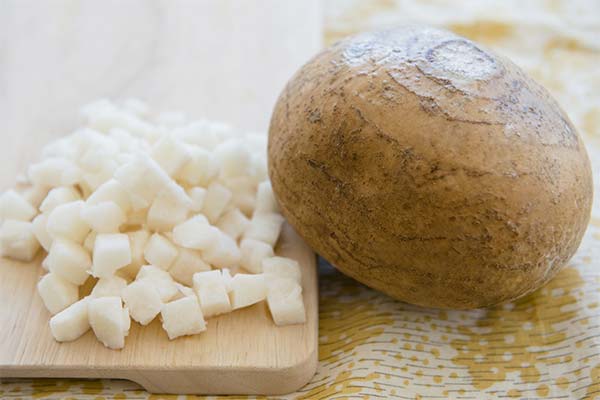
Before removing the skin, the vegetable should be washed. Then cut off the top and bottom so that the hickama lies steadily on a cutting board. After that, remove the skin from the rest of the root vegetable, using a knife.
It can be eaten raw, as a snack and in salads, or boiled, stewed, or fried. In countries where this exotic plant grows, fruit cocktails are prepared from the hickam and it is used in baking as a source of starch.
What you can make with chicam
In Mexico, tourists are often offered a spicy snack of chilled vegetable slices sprinkled with lime juice and sprinkled with chili powder and salt.
A salad of carrots, dates, raisins, and pachyrhizus
Raisins and dates are taken in equal proportions, peeled of seeds and shredded. To prepare the dish you will need 4 tbsp. of the mixture. Squeeze the juice from one lime fruit and add it to the raisins and dates. After that they are placed in the fridge for 15-20 minutes, so that the mixture can infuse.
Grate about 0.5 kilograms of Hickam pulp on a coarse grater, add chopped julienne carrots and combine all the ingredients in a dish to be served. Add salt to taste, season with olive oil. You can sprinkle finely hand torn mint leaves on top.
Puffed Sweet Salad
Cook it on a flat dish so that all the layers are visible. This way it will look even more appetizing. The bottom of the salad bowl is filled with torn lettuce leaves. The next layer is finely chopped cubes of hickory pulp. They can be sprinkled with a little salt, so the flavor of the root vegetable will be more pronounced.
Apples, mandarin and grapefruit are peeled from the skin, pips, membranes and sliced. The layer of Mexican yam is filled first with apples, and then with a mixture of citrus fruits. Pomegranate grains are placed on top.
Mix the juice of orange and grapefruit in equal proportions, pepper it a little, and pour it over the resulting salad. Then sprinkle with corn oil and sprinkle with sesame seeds. A few drops of honey can add a unique flavor to the dish.
Leave the salad for an hour in the fridge to infuse it before serving.
Quick Hickam Vegetable Soup
Finely chopped carrots and onions are sauteed in sunflower oil. Sweet bell pepper, white cabbage and hickama sliced julienne.
Shredded cabbage and green beans in pods are put in boiling water and brought to half-cooking. Afterwards, salt and pepper the soup and put the rest of the vegetables. On each plate chopped greens, mint leaves and sour cream can be added to taste.
You can also eat it cold.
Guacamole sauce
This sauce goes well with roast meats, boiled potatoes, and pasta.
Roast chili peppers in vegetable oil until bubbles appear on the skin. Then remove the core and peel it. Finely chop the pulp.
Peel and chop the mango into small pieces. Mix the chili pepper, mango, chopped coriander, red onion and lime juice in a bowl. Season with salt and pepper to taste. Allow the mixture to stand for 15 minutes. Grate Avacado and Hikama to form a pureed mass. Then pour it into the peppered mixture. Add a tablespoon of olive oil and mix thoroughly.
Dumplings with shrimp
Batter: In 400 grams of flour, add 1 cup of water and a pinch of salt. Knead until the dough doesn't stick to your hands. After that, cover it with a towel and leave for 20 minutes at room temperature.
Stuffing: Boil shrimp, peel and mix with grated hikama, finely chopped green onions. Add a pinch of corn starch, 2 tablespoons of sesame oil, salt and pepper to taste. Cool the mixture for 5 minutes.
Make dumplings, put stuffing and make pierogies. The tastiest dumplings are steamed. It takes 8-10 minutes to be fully cooked in a multicooker.
Serve with sauce. It is prepared with green onions, 1 tsp. soy sauce, 3 tbsp. lemon juice and 1/2 tsp. sesame oil.
Traditional medicinal uses
Hikama is not used in official medicine. Due to its composition, the vegetable is most often advised for use in obesity. You can eat it as part of salads with avacados and tomatoes.
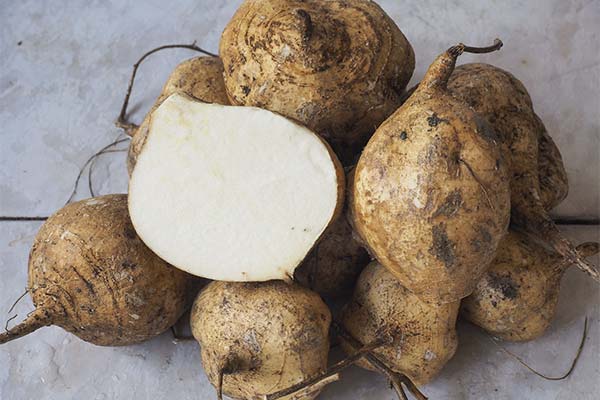
To normalize blood pressure and improve metabolism, folk healers recommend including Mexican yam in fruit or vegetable smoothies.
To reduce blood sugar and cholesterol, it is enough to eat 200 grams of peeled pulp per day.
It is rumored that local healers use the juice of this plant to prepare potions to get rid of various skin diseases. The recipe is kept in the strictest secrecy.
Cosmetological applications
Unlike medics, cosmetologists long ago noticed this exotic vegetable and managed to appreciate it. Its extract has a refreshing effect on the skin. It moisturizes, cools and whitens it. To do this, just grate a pulp of hikam pulp on your face and leave it for 10-15 minutes. After that, wash your face with warm water. Two or three masks a week will make your skin fresh and healthy.
In Asian cosmetics, you can find ready-made skin care products, which includes Mexican yam: masks, scrubs, soaps, lotions. They are especially good for people with problem skin, including against the background of hormonal disorders.
How to grow Hikama
It is quite difficult to grow hickamas on a plot, because climatic conditions do not allow this plant to fully develop. However, it is possible to get smaller tubers. As a rule, one of two species is planted in places atypical for the growth of this root crop: milk hickama or water hickama. The former has more elongated tubers and a whitish sap. The second has rounded rootlets and a clear juice.
Growing a plant from tubers is quite difficult, so most fans of exotic plants use seeds.
Sow the seeds in March-April, pre-soaking them for a day in water. Soil for future seedlings is made quite loose. Medium loamy soil is best. At a temperature of +25-27 ° C sprouts appear after 7-10 days. In the open ground seedlings can be transplanted at night temperatures not below +20 ° C. Otherwise, the plant stops growing and may die. For planting, choose a well-lit area, where the sun is at least 7-8 hours a day. On the roots of seedlings it is worth to keep the priming, so they will better acclimatize to the new place. The soil should be abundantly watered. It is also necessary to take care of trellises, which will support the growing vines.
About 2 months after sowing the seeds, the first flowers will bloom. Hickama is a self-pollinating plant, so there is no need to worry about it.
When watering it is necessary to observe moderation, as the plant more easily tolerates drought than excessive moisture. With fertilizing, it is also important not to overdo it. Only three times a season is enough. Form the bush by pruning the upper part.
The tubers should be dug before the first frosts. For their full formation, it takes about 150 days from the moment of planting the seeds.
When taking care of hickamas, safety precautions are necessary, since all the above-ground parts of the plant are poisonous. Ingestion of rotenone toxin can be life-threatening.
«Important: All information on this site is provided for informational purposes only. for your own health. Consult a health care professional before using any of the recommendations. Consult a health care professional before using any of the recommendations. Neither the editors nor the authors shall be liable for any possible harm caused by materials."

